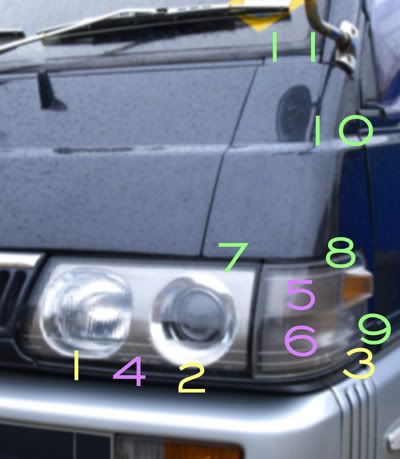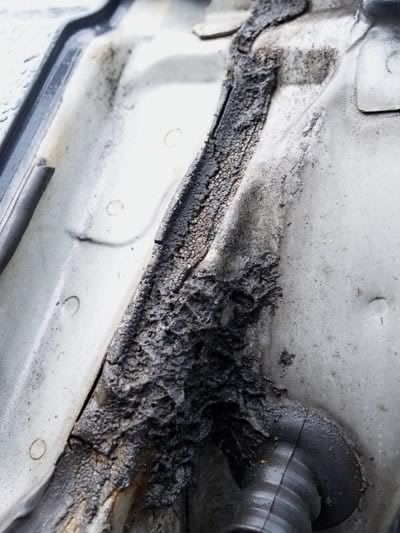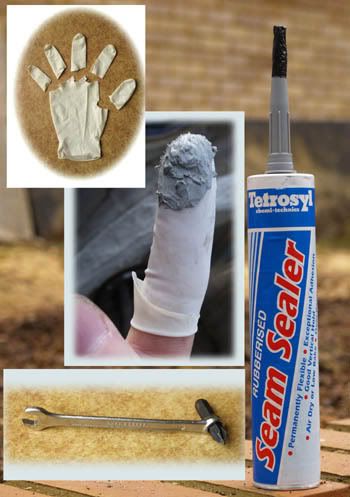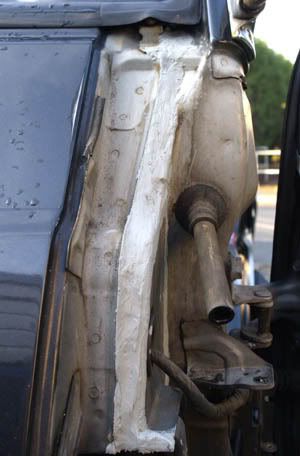Morgonzo
Active Member
Hello all my Delica Brothers and Sisters, I wanted to share a couple of pics with you of my seam sealing adventures to stop the wet floor-board syndrome and stop my footwells from rusting.
I don't know how long it was leaking for, but in February I finally pulled back the drivers carpet and found this... no bueno! I knew it was time to do the front seam seal job. The first thing to do is remove the headlight bezels..
no bueno! I knew it was time to do the front seam seal job. The first thing to do is remove the headlight bezels.. Three Phillips head screws hold these on, one in the door jamb and two in front under the lenses. Gently pull forward and the clips will pop out. Safely set aside. Next to remove is what i've been referring to as the "Cheeks" of the van. This was the hardest part for me. There are 4 screws holding this panel on. 1 in the door jamb (easiest to get out but not easy!) 1 under the windshield rubber
Three Phillips head screws hold these on, one in the door jamb and two in front under the lenses. Gently pull forward and the clips will pop out. Safely set aside. Next to remove is what i've been referring to as the "Cheeks" of the van. This was the hardest part for me. There are 4 screws holding this panel on. 1 in the door jamb (easiest to get out but not easy!) 1 under the windshield rubber  and two above the headlights (PITA!) I adopted a special approach to get these out..a wood chisel wedged beneath a ring-end wrench with the phillips bit taped into it. I used the chisel to apply upwards pressure to get the bit to bite. These screws were NOT coming out without a fight. I went and bought a brand new screwdriver bit set just so I wouldn't strip out the heads of the screws. Lot's of PB Blaster later...
and two above the headlights (PITA!) I adopted a special approach to get these out..a wood chisel wedged beneath a ring-end wrench with the phillips bit taped into it. I used the chisel to apply upwards pressure to get the bit to bite. These screws were NOT coming out without a fight. I went and bought a brand new screwdriver bit set just so I wouldn't strip out the heads of the screws. Lot's of PB Blaster later... GROSS! the other side was the same. Time for the wire brush....
GROSS! the other side was the same. Time for the wire brush.... Looks better, time for a beer and the Metal de-
Looks better, time for a beer and the Metal de- greaser....now with it clean i'll apply the seam sealer
greaser....now with it clean i'll apply the seam sealer  an important thing to look at is the seam to the side that extends straight down just behind the wire in the pic where you can see a touch of grey. I scraped as far down as I could reach and then applied the sealer over the whole area. The product i used was Dynatron grey seam sealer#550 and got from Vatozone for around 12 bucks. Now that you've sealed all the seams, just put it all back together and Voila! No more wet floors! It's been a couple of months since I did this and we've had HEAVY rain lately and I'm happy to report that my carpets and floorboards have remained dry no matter how hard the rain.
an important thing to look at is the seam to the side that extends straight down just behind the wire in the pic where you can see a touch of grey. I scraped as far down as I could reach and then applied the sealer over the whole area. The product i used was Dynatron grey seam sealer#550 and got from Vatozone for around 12 bucks. Now that you've sealed all the seams, just put it all back together and Voila! No more wet floors! It's been a couple of months since I did this and we've had HEAVY rain lately and I'm happy to report that my carpets and floorboards have remained dry no matter how hard the rain.
It's not hard, and even if your van isn't leaking it's worth doing for piece of mind.
Cheers,
Morgonzo.
I don't know how long it was leaking for, but in February I finally pulled back the drivers carpet and found this...
 no bueno! I knew it was time to do the front seam seal job. The first thing to do is remove the headlight bezels..
no bueno! I knew it was time to do the front seam seal job. The first thing to do is remove the headlight bezels.. Three Phillips head screws hold these on, one in the door jamb and two in front under the lenses. Gently pull forward and the clips will pop out. Safely set aside. Next to remove is what i've been referring to as the "Cheeks" of the van. This was the hardest part for me. There are 4 screws holding this panel on. 1 in the door jamb (easiest to get out but not easy!) 1 under the windshield rubber
Three Phillips head screws hold these on, one in the door jamb and two in front under the lenses. Gently pull forward and the clips will pop out. Safely set aside. Next to remove is what i've been referring to as the "Cheeks" of the van. This was the hardest part for me. There are 4 screws holding this panel on. 1 in the door jamb (easiest to get out but not easy!) 1 under the windshield rubber  and two above the headlights (PITA!) I adopted a special approach to get these out..a wood chisel wedged beneath a ring-end wrench with the phillips bit taped into it. I used the chisel to apply upwards pressure to get the bit to bite. These screws were NOT coming out without a fight. I went and bought a brand new screwdriver bit set just so I wouldn't strip out the heads of the screws. Lot's of PB Blaster later...
and two above the headlights (PITA!) I adopted a special approach to get these out..a wood chisel wedged beneath a ring-end wrench with the phillips bit taped into it. I used the chisel to apply upwards pressure to get the bit to bite. These screws were NOT coming out without a fight. I went and bought a brand new screwdriver bit set just so I wouldn't strip out the heads of the screws. Lot's of PB Blaster later... GROSS! the other side was the same. Time for the wire brush....
GROSS! the other side was the same. Time for the wire brush.... Looks better, time for a beer and the Metal de-
Looks better, time for a beer and the Metal de- greaser....now with it clean i'll apply the seam sealer
greaser....now with it clean i'll apply the seam sealer  an important thing to look at is the seam to the side that extends straight down just behind the wire in the pic where you can see a touch of grey. I scraped as far down as I could reach and then applied the sealer over the whole area. The product i used was Dynatron grey seam sealer#550 and got from Vatozone for around 12 bucks. Now that you've sealed all the seams, just put it all back together and Voila! No more wet floors! It's been a couple of months since I did this and we've had HEAVY rain lately and I'm happy to report that my carpets and floorboards have remained dry no matter how hard the rain.
an important thing to look at is the seam to the side that extends straight down just behind the wire in the pic where you can see a touch of grey. I scraped as far down as I could reach and then applied the sealer over the whole area. The product i used was Dynatron grey seam sealer#550 and got from Vatozone for around 12 bucks. Now that you've sealed all the seams, just put it all back together and Voila! No more wet floors! It's been a couple of months since I did this and we've had HEAVY rain lately and I'm happy to report that my carpets and floorboards have remained dry no matter how hard the rain. It's not hard, and even if your van isn't leaking it's worth doing for piece of mind.
Cheers,
Morgonzo.































